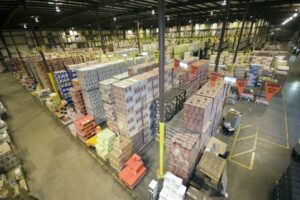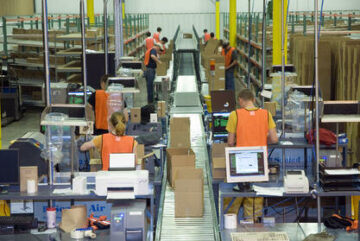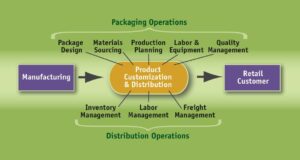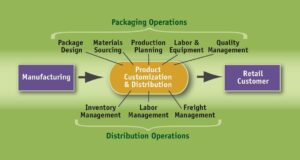During the COVID-19 pandemic, warehouse worker protection has emerged as a critical core competency for corporate logistics departments and their 3PL partners. Business continuity literally depends upon it since a virus outbreak could close down a distribution warehouse.
But getting serious about worker protection requires more than investing in extra PPE and setting up a few wash stations. It requires a significant investment of time and money.
 At Kane Logistics, company investments in warehouse worker protection have included high-ticket items like thermal temperature scanners and bio-sprayers for sanitizing facilities and equipment, plexiglas barriers and physical workplace modifications, and a wide array of PPE and sanitation supplies.
At Kane Logistics, company investments in warehouse worker protection have included high-ticket items like thermal temperature scanners and bio-sprayers for sanitizing facilities and equipment, plexiglas barriers and physical workplace modifications, and a wide array of PPE and sanitation supplies.
Management focus has not waned even a year into the pandemic. Departmental leaders meet together three times weekly to discuss short- and long-term measures to ensure workers are safe and customer operations stay productive. Site leaders engage directly with workers daily, reinforcing safety protocols and processes.
According to Sherrie Miller, Kane’s VP of Sales Operations, Planning and Marketing, who also serves as organizer/ team quarterback of the KANE COVID-19 Task Force, it takes discipline to sustain a heightened focus on safety for a long period.
“We’ve all seen accounts from essential workers reporting that their companies are not walking the talk and who don’t feel safe in their workplace,” she says. “KANE is committed to keeping safety first and treating our associates like family. We believe in making our work environments the absolute safest they can possibly be, because family takes care of one another. At the end of our COVID task force meetings we ask ourselves: is there anything more we could be doing for associate safety? If the answer is ever ‘yes’ we’re committed to figuring out how to implement it.”
KANE’s sustained focus on warehouse worker protection has been effective. KANE has maintained business continuity for all customers at all sites throughout the pandemic. Also, KANE’s overall COVID positivity rate is less than the average rate of the counties in which we operate. This is particularly impressive since the overall average includes people working at home and isolating, while KANE’s number is exclusively essential workers who are reporting to busy distribution and packaging facilities every day. Read KANE’s full eBook on Safety in Logistics.
Effective strategies for warehouse worker protection
Here are some of the worker protection strategies KANE has used successfully during the pandemic.
Seek professional advice
In the Spring of 2020, KANE brought on Dr. David Cohn from the Ohio State University College of Medicine to serve as medical advisor during the pandemic. Dr. Cohn continues to take part in regular calls and provides professional advice on how to meet all regulatory requirements. KANE also engaged experts in public health and risk mitigation in 2020 when we developed our initial COVID-protocols.
Do large-scale temperature screening
No one with an elevated temperature is admitted to KANE facilities. But the job of temperature screening is challenging in facilities with hundreds of workers. That’s why KANE has invested to have at least one scanner at each of its nationwide facilities, with larger facilities having as many as four scanners at separate building entrances. At the largest sites, KANE has installed $30,000 FevIR Scan machines for high-volume temperature scanning.
Implement social distancing and dividers
 KANE has instituted staggered shifts whenever possible and reconfigured break rooms to promote social distancing. We’ve also affixed floor decals as visual reminders of the 6-foot rule. In certain packaging operations, 6-foot distancing is not possible given the nature of the work, so KANE has invested to install plexiglass dividers (see photo). In one 3PL contract packaging operation, the dividers helped to generate a 26% productivity gain, helping the site to break a 9-year record in spite of the pandemic.
KANE has instituted staggered shifts whenever possible and reconfigured break rooms to promote social distancing. We’ve also affixed floor decals as visual reminders of the 6-foot rule. In certain packaging operations, 6-foot distancing is not possible given the nature of the work, so KANE has invested to install plexiglass dividers (see photo). In one 3PL contract packaging operation, the dividers helped to generate a 26% productivity gain, helping the site to break a 9-year record in spite of the pandemic.
Create associate roles that are 100% dedicated to sanitation and worker safety
Some KANE associates’ sole job is cleaning. Using approved sanitation supplies which include industrial-grade bio-sprayers, they clean equipment and high-traffic areas throughout the building and, when they complete the process, immediately start again.
Avoid top-down approach to communication and compliance
KANE has gone all-in on more of a peer-to-peer approach to associate communication about virus protection in the DC. Every site has a COVID-19 Coordinator who, importantly, is not the distribution center manager. It’s someone – like a forklift operator or a customer service rep – who has volunteered to disseminate safety information and solicit concerns from the team. This COVID Coordinator receives a quarterly stipend to perform these extra duties.
The peer-to-peer approach has been far more effective than top-down management mandates in gaining compliance with safety protocols. Associates on the floor are the most vulnerable and appreciate a structure where they can openly air concerns and get their questions answered. These Coordinators are included in regular calls with Dr. Cohn and the entire KANE management team, where they are able to communicate directly with the top leadership and experts.
COVID Coordinators also attend a weekly call with the Safety and Human Resource departments on any updates and communications. In addition, this team meets weekly with the procurement department to ensure sites have the necessary number of supplies to help keep everyone safe.
KANE’s safety department is regularly researching new technology and controls that will assist our site management teams.
COVID-19 remains top of mind for customers
In business reviews with customers, COVID-19 remains the #1 concern. They are interested in safety protocols and what is being done to ensure business continuity.
To truly “walk the talk” when it comes to worker protection, 3PLs need to invest to make warehouse worker protection a new core competency – along with picking, packing, shipping and inventory management.
If you need a 3PL that puts safety first, contact KANE today to start a conversation.
Source: https://www.kanelogistics.com/blog/warehouse-worker-protection-dc-operations
- "
- 000
- 2020
- Absolute
- advice
- advisor
- All
- auto
- barriers
- Building
- business
- business continuity
- call
- care
- Cleaning
- code
- College
- Communication
- Communications
- Companies
- company
- compliance
- continues
- contract
- Covid
- COVID-19
- COVID-19 pandemic
- Customer Service
- Customers
- day
- dc
- eBook
- Effective
- equipment
- experts
- family
- First
- Focus
- full
- Health
- Home
- How
- How To
- HTTPS
- HubSpot
- Hundreds
- information
- inventory
- Inventory Management
- investing
- investment
- Investments
- IT
- Job
- keeping
- Leadership
- logistics
- Long
- Machines
- Making
- management
- Marketing
- medical
- medicine
- meetings
- money
- Ohio
- Operations
- outbreak
- packaging
- pandemic
- People
- planning
- PPE
- productivity
- promote
- protection
- public
- public health
- Requirements
- resource
- Reviews
- Risk
- Risk Mitigation
- Rooms
- safe
- Safety
- sales
- scan
- scanning
- setting
- Shipping
- Sites
- So
- Social
- social distancing
- spring
- start
- State
- stay
- task force
- Technology
- thermal
- time
- top
- treating
- university
- Updates
- virus
- Vulnerable
- walking
- Warehouse
- weekly
- What is
- WHO
- Work
- workers
- Workplace
- year











